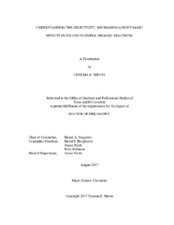| dc.description.abstract | Statistical models, like Transition State Theory (TST), are used in order to predict rates and selectivities of reactions. However, these models often fail to explain experimental results. In such cases, consideration of non-statistical dynamic effects is necessary to understand the experimental observations. Here, we present the study of a series of organic reactions, including: the nitration of toluene using nitronium salts, the Friedel-Crafts acylation of aromatic ethers, the Cope-type hydroamination of alkynes, and Diels-Alder cycloadditions. In order to understand the mechanism and dynamic effects involved in these reactions, a combination of experimental kinetic isotope effects (KIEs) and computational chemistry were employed. KIEs were determined using 1D ¹³C NMR.
Solvent dynamics play a very important role in the product selectivity of the nitration of toluene. For this reaction, computational studies showed that the experimentally observed product selectivity does not involve any transition states. Also, dynamic trajectories using an implicit solvent model fail to account for the experimental product selectivity. However, the use of an explicit solvent model showed the importance of the solvent and counter ion reorganization, and their impact in the reaction’s selectivity.
For the Friedel-Crafts acylation of aromatic ethers, KIEs showed that they are affected by a bifurcating energy surface. In these reactions we found that the first step, formation of a C – C bond, is the rate-limiting step. However, KIEs showed that this step is affected by a bifurcation on the free energy surface. Computational studies were able to explain the experimental results.
The hydroamination of alkynes was studied in order to get a better understanding of the mechanism involved in this process. KIEs and computational results were in agreement with a process that occurs via a 5-membered-ring TS. In addition, the results showed how KIEs can give an accurate description of the TS involved in the process.
Finally, KIEs obtained for the Diels-Alder cycloaddition of p-chlorobenzaldehyde with an asymmetric silyl-diene showed the possibility of the reaction proceeding via a two-step process on the free energy surface, but as “seemingly concerted” reaction in potential energy. These results imply that the reaction is affected by non-statistical recrossing. | en |


